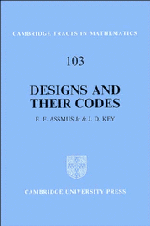1 - Designs
Published online by Cambridge University Press: 05 October 2015
Summary
Introduction
We begin by discussing those basic concepts from design theory needed in our development of the use of linear codes as an aid in organizing and classifying designs. The more specific properties of those designs that we use as examples of this development will follow in the chapters devoted to the class of designs in question. Much of the material in this chapter is now quite standard and treatments can be found in related books on designs and geometries, in particular the books of Beth, Jungnickel and Lenz [37], Dembowski [85], Hall [122], and Hughes and Piper [144]. The books of Cameron [63], Cameron and van Lint [64], and Tonchev [281] are also useful for related material, and Batten [31] has an elementary account that highlights the geometry. We restrict our attention to finite structures, however, and whenever a set, group, or other mathematical structure is mentioned the reader should assume it to be finite. For background material the books by Wielandt [296] and Passman [232] can be consulted for permutation groups, and that by Lidl and Niederreiter [185] for Galois theory and finite fields.
Basic definitions
The most basic structure of the theory is a finite incidence structure which we denote by S = (P, B,T), and which consists of two disjoint finite sets P and B, and a subset I of P x B. The members of P are called points and are generally denoted by lower-case Roman letters; the members of B, are called blocks and are generally denoted by upper-case Roman letters. If the ordered pair (p, B) is in I we say that p is incident with B, or that B contains the point p, or that p is on B, using the general phraseology of geometry, and viewing the incidence structure geometrically. The pair (p, B) is called a flag if it is in I, an anti-flag if not.
- Type
- Chapter
- Information
- Designs and their Codes , pp. 1 - 24Publisher: Cambridge University PressPrint publication year: 1992



